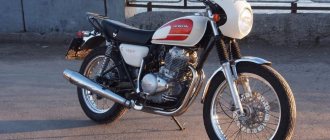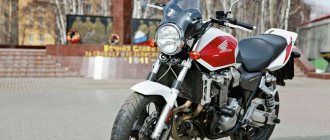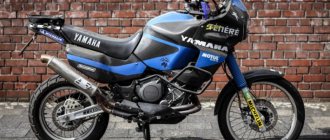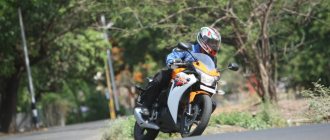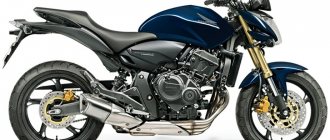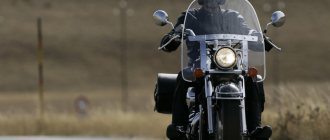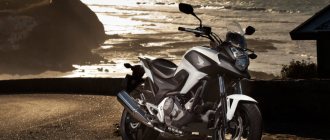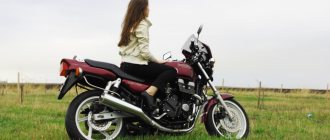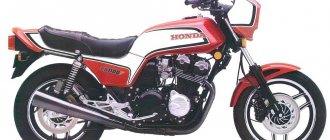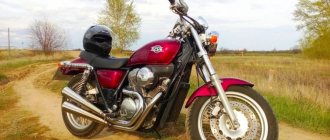| Honda CBR750 Hurricane (Super Aero), 1987 | Honda CBR750 Hurricane, 1988 |
Honda CBR750 sports tourer model
appeared in 1987 on the domestic Japanese market.
The factory name of the model is Honda CBR750F
.
The motorcycle had the Hurricane
in its name, which was also applied to the plastic.
The first modifications of the motorcycle (1987) also had the designation Super Aero
(it was applied to the rear part of the plastic).
The Honda CBR750 model is built on a common frame with the Honda CBR1000F and has much in common with the first generation of this motorcycle, which is also considered the successor to the CBR750.
The Honda CBR750 is based on an in-line 4-cylinder liquid-cooled engine with a volume of 748 cm³ and producing 77 hp. power and 70 Nm of torque. The engine is distinguished by gear drives of timing camshafts.
In 1988, the model underwent minor changes, losing the Super Aero prefix in the name and the engraving on the rear of the plastic. The updated version also gets separate rear turn signals (instead of integrated ones at the rear of the motorcycle), changes to the front suspension (TRAC anti-dive system has been removed) and floating front brake discs. The crankcase volume was increased to 4.3 liters, and a luggage hook was added for securing cargo. The weight of the motorcycle has increased by 3 kg.
The same year was the last year of production of the model. A total of 9,500 motorcycles were produced (8,000 in 1987, 1,500 in 1988).
The main competitors of the Honda CBR750 in the class:
- Kawasaki ZXR750
- Suzuki GSX750F Katana
- Yamaha FZ750
001_MOTO_0610_064
But the engine worked like a clock. But when I got my appearance in order, a friend decided to take my Hurricane for a ride and... got into an accident. I had to pick up my dream piece by piece. The fairing and side plastic mounts suffered the most. The mufflers were dented so badly that they interfered with the normal operation of the pendulum. The fairing was crushed, the motorcycle lost its newly installed turn signals and mirror, and the instrument panel was torn from its mounts. Parts hidden from view, including the frame, were also severely damaged. Not even the ignition key survived. I decided to make the motorcycle more reliable, safer, and at the same time “rejuvenate” its appearance. I didn't have to cover a bunch of paper with drawings, sketches and notes. The new cladding was born in thoughts, developed and came into being in one breath. I decided to do the work sequentially, moving from simple parts to more complex and labor-intensive ones.
Dimensions and weight
Official modifications differed not only in internal filling, but also in external characteristics.
Weight:
- the motorcycle's dry weight was 215 kg ;
- equipped - 235 kg .
The American version had 210 kg and 226 kg respectively.
Dimensions:
10-15 mm larger . The bike had:
- length - 2,221 mm;
- width - 780 mm;
- height - 1,100 mm.
- Seat height - 795 mm.
- Wheelbase - 1,495 mm.
The Japanese got a slightly different geometry - the bike was higher in overall height, but lower in the saddle.
003_MOTO_0610_065
The idea to cage the motorcycle in a cage of protective bars was born immediately after an unsuccessful slide and flip. Following the advice of an experienced stunt rider, I secured its bases with clamps. Damage to the frame from falls will be minimal, and, in addition, the cage can be easily removed and repaired. The protection is welded from 36 pieces of steel pipe with a diameter of 22 mm. An all-metal rod is hidden inside, which adds strength. If you fall, the front fork will inevitably twist, but the handles, clip-ons, turn signals and, most importantly, the hands will remain unharmed, because the upper “protection” fastenings are located directly under the handles and at a sufficient distance from the facing. Fortunately, I haven’t had to try this in practice yet. But with the protective bars, rolling the motorcycle and placing it on the center stand has become much more convenient.
Honda CBR1000F Hurricane 1987-1988
When that big Honda motorcycle came out in 1987, it tore through the motorcycle world like a Category 3 hurricane through Florida...sorry, couldn't resist the comparison.
With more horsepower and a speed faster than any previous liter engine motorcycle, it took the whole concept of motorcycle performance to a new level. Yes, the 600cc and 750cc bikes may have played an important role in the racing motorcycle categories, but the 1000cc class has become the playground for the machines that really fit that bill. And the game has been updated with 10,000 rpm liquid-cooled engines and serious motorcycle body aerodynamics. Suzuki started the game with its GSX-R1100, which has an increased engine capacity of 1052.5 cm3. The Kawasaki Ninja 1000R (997.8 cc) followed and the Honda (998.4 cc) followed and the new Yamaha FZR1000 (989.6 cc) was introduced right after the Honda. It should be noted that the letter R (racing?) is always present in the model designation. This is a fashionable letter, despite the fact that the motorcycles were not designed for track racing.
This rivalry was intimidating, but fans of fast motorcycle riding were attracted not only by the 110 hp power shown by the Honda motorcycle on the stand, and not by the smooth fairings, but by the fact that the motorcycle was so suitable for riding. If you are going to race for a couple of hours at a motorcycle track, comfort is not so important. But if you plan to ride it all day, your priorities change. A few words about his name. Back in the mid-1950s, many British motorcycles had rather boring names, or simply alphanumeric designations. And American importers wanted to excite buyers more. In 1957, importer Matchless/AJS rebadged the company's 600cc Scrambler twins. These were almost identical cars with the rather mysterious names G11CS (Matchbox) or Model 30CS (Ajay). And what name did they get? Of course, Hurricane! (Hurricane.)
Headlight on 1987 Honda CBR1000F Hurricane
Soon the Scrambler 600cc single-seater motorcycle became the Typhoon, and the 250 version was named Tornado. Not wanting to be outdone, Ariel renamed its 650 Huntmaster Twin Cyclone. The Hurricane name disappeared a few years later as the British motorcycle industry slowly imploded, and it remained unused until 1973 when Craig Vetter named his updated BSA Triumph X75 motorcycle in the proud Hurricane name. This wonderful exercise in style, unfortunately, did not last long. Honda was slow to give its models fancy names, but by 1980 its marketing department realized that motorcyclists, especially in the United States, liked to give their cars shiny names... like Interceptor. It should be noted that this name was first used in 1962, for the Royal Enfield 750 twin cylinder motorcycle. The concept of the Interceptor - a fast fighter aircraft - won the hearts of the public with its attitude towards speed. So why not use the wind power of Mother Nature herself - the storm? The Honda Hurricane 1000 motorcycle appeared in 1987, replacing the Interceptor 1000. It must be admitted that the old Soichiro Honda was an outstanding and capable businessman. He would have been a damn good poker player because one of his many strengths was knowing when to fold. For example, in the case of the V-4 Interceptor model. Of course, both the V-4 name and designation are still used on the VFR800 Interceptor, but it's unlikely that it would have attracted buyers 20 years ago.
1987 Honda CBR1000F Hurricane
The world Honda put the motorcycle world on its ear when it introduced the CB750 in 1969, an inline-four engine. This motorcycle was powerful, reliable and inexpensive. Then he decided to play up his ace, so to speak, and in 1081 rolled out the 750cc V-4 Saber and Magna models to the stand in Marysville, Ohio. Then, a year later, came the Interceptor 750. It had a 2-cylinder engine with an overhead camshaft, four valves per cylinder and, note, liquid cooling. Soon the Interceptor, 500 and 1000 motorcycles would join the fleet, and Soichiro Honda could expect someone else to do it again. Except that the Interceptor motorcycles had growing pains, which gave them a bad reputation, and they were redesigned to fit into the sport-touring motorcycle category. In 1987, Hurricane motorcycles, both the 600 and 1000 became the new "top boys in the village." They had in-line four-cylinder, liquid-cooled engines that debuted on the Kawasaki Ninja 900 in 1984. There was nothing fundamentally new about the 1000 Hurricane engine, it was just that, in typical Honda fashion, a significant amount of research and design effort had gone into its development. The new engine was very compact, had a narrow design, compensated by the axis of the balancer, rotating twice as fast as the crankshaft. With both a 77mm bore and 53.6mm stroke, this engine was superior to most Big Four liter engines in 1987, thanks to large 38mm carburetors feeding large volumes of fuel through large valves into large combustion chambers.
Honda CBR1000F Hurricane front fork
The engine has become a significant stress element of the chassis. It was securely bolted at five points into a heavy, box-like steel frame that ran along the perimeter of the body, minimizing the possibility of deformation. By today's standards, the motorcycle's suspension was not very sophisticated. The only adjustment on the front 41 Showa fork was air pressure, although it did have a hydraulic anti-dive mechanism. The single rear shock, also Showa, allowed for adjustable spring tension and rebound damping. It's all pretty rudimentary compared to today's CBR1000RR (three R's!). The transmission had six gears. The most innovative aspect of the Hurricane was its appearance - the fairing. No Japanese motorcycle has ever been covered to such an extent, and only the Ducati Paso has been more successful in this quest to hide what's inside. True, this was connected not so much with appearance, but with driving characteristics, or, ultimately, with maximum speed. The ability to achieve top speed for a production motorcycle is considered very important in the market, and the aerodynamics of this fairing were excellent. Several testers were able to push the Hurricane to speeds in excess of 160 mph (257 km/h) - which is completely impractical for the average buyer. Buyers love comfort. The handlebar grips were not too thin and not too low. Its seat was pleasant to sit on, and the ergonomics were generally consistent with a normal representative of the human race. A couple of side racks and a fuel tank rack made for a thousand mile weekend drive. However, the US economy was experiencing a slight depression, sales were slowing, and by 1989, the CBR1000F Hurricane had fallen off the market. It appeared in 1990, but without the Hurricane name. It was said that with a simple alphanumeric designation like the CBR1000F, insurers would be more willing to insure it, because a name like Hurricane connoted recklessness and depravity, and caused insurance rates to be too high. Now you know what's hidden in the name.
005_MOTO_0610_065
The mirrors, fairing, rear and lower parts of the motorcycle were made from sheet metal. When creating iron cladding, I was inspired by the fact that I had never seen anything like it, as well as by the skeptical attitude of certain individuals. The only disadvantage of metal is its weight, but the structure made of iron plates 0.5 mm thick is not much heavier than high-quality plastic, but incomparably stronger. In my opinion, working with steel is much easier than working with plastic.
009_MOTO_0610_065
I paid special attention to the exhaust system. I put new, longer and wider ones (they were made at the factory) directly on the crumpled standard mufflers. The size of the mufflers is directly related to safety - in the event of a fall, it is they that will take the entire impact, the “tail”, all the legs and footrests will remain unharmed. With the new mufflers the sound became lower and boomier, especially at low speeds.
006_MOTO_0610_065
The new rear optics consist of foglights from Lada-Kalina with implanted red LEDs. The standard, glaring headlight was replaced with more accurate and modern high beam headlights in the center and two fog lights, designed to provide low beam, at the edges. The optics cope with the task no worse than native ones. I deliberately painted over the transparent glass of the windshield so that there would be no desire to stick to the gas tank and “unscrew” as much as possible. The fairing is topped with the same struts with new, longer homemade mirrors - visibility in them is much better than before. The turn signal spark plugs seem to have been created for this motorcycle, and they are even brighter than before, despite their miniature size.
014_MOTO_0610_065
Having finished the work, I decided to take it for a test drive and give the whole new thing a good shake. Returning to the garage, I scrupulously searched the entire mots in search of “jambs”. My joy knew no bounds - the bike passed the running tests. And the slight increase in weight had no effect on either the suspension or braking performance. When all the “clumsy” work was done, it was time to think about the “jewelry” work. Like previous operations, I decided not to trust anyone with the painting. I came up with something between expensive and complex airbrushing and basic repainting - a method that does not require expensive equipment, “laboratory conditions” and special talent. I sealed each color with a stencil of automotive tape in those places where the color matters. Then I covered the cladding with the next layer of a different color. After it had dried, I again covered the necessary fragments with tape, and at the end, after removing the stencils, I secured the drawing with a layer of transparent varnish.
Specifications
An interesting solution for the engine was the installation of hydraulic compensators, thanks to which there was no need to adjust the valves.
Engine – right side view.
Engine – left view.
Otherwise it was a standard 4-cylinder, 4-stroke engine .
- working volume - 747 cm3;
- power - 75 hp;
- number of valves - 16;
- cylinders - 4;
- cooling - air-oil;
- fuel supply - carburetor (Keihin 34 mm);
- ignition - transistor;
- start - electric starter;
- fuel tank - 20 l.
To comply with the new legislative framework, Japanese models received a redesign in 2001, but the developers did not “strangle” the engine. The bike for the domestic market was equipped with a different frame model, a modified exhaust system and different carburetors. The redesign turned out to be so successful that the new bike could be purchased in Japanese markets until 2008 .
Transmission and clutch
The motorcycle transmission is based on a classic chain drive.
The motorcycle received a 5-speed gearbox.
According to users, the box is not bad, but the gear ratios do not provide fast dynamics, and in most cases, engaging the 5th stage is impossible.
The developers noticed that the bike is not a city bike, but a road bike . And when driving on the highway, dynamics are far from the first place in the line of qualities.
- Multi-disc clutch, oil bath . The transmission of power depended on the specific motorcycle. Both hydraulic and standard cable solutions were produced.
- Main drive - chain.
Brakes
Depending on the modifications, the bike's brakes also had different designs. From 2-disc hydraulics on the front axle to drums on the rear. Therefore, the list will have two values, for both official modifications.
Front double disc brakes.
Rear disc brakes.
Front: brakes:
- number of disks - 2 (1);
- diameter - 296 mm;
- support - 2 (1) piston.
Rear brakes:
- number of disks - 1;
- diameter - 240 mm;
- support - 1-piston, or drum design.
No options were offered for either model.
015_MOTO_0610_065
A year of continuous work - and the result exceeded all expectations. I registered the motorcycle without any problems and passed the technical inspection. I rode off the season without falls, scratches or dents, having listened to a lot of kind words addressed to my truly iron horse. For the 20th anniversary of my CBR, I gave it a second youth. Happy birthday, Hurricane!
DIY custom - Honda CBR750 Hurricaine
Flaws
During ownership, users noted the following disadvantages.
- Brakes . The bike is heavy, maximum speed is achieved without difficulty, and the brakes are weak. We are not talking about versions for Americans at all - the drum is useless at speed.
- Reserve tap . General leakage. Finding a new problem can be treated simply by removing it and connecting directly.
- Vibrations . At medium speeds for the urban cycle, vibrations begin. There is no treatment.
The general old age of the car was separately noted. Used components, developed in the middle of the last century .
and dignity
There are more advantages.
- Reliability . Despite its obsolescence, the motorcycle is very easy to maintain and reliable.
- Cooling . As bikers say, the fewer parts a motorcycle has, the less it breaks. An air filter can be found at any auto store.
- Hydraulic compensators . The only model where you don’t need to bother with periodic checking and tightening of valves. He will do everything himself. Users recommend using a more viscous oil.
- Controllability . Ideal weight distribution made for ideal handling. And the large mass did not become a problem.
- Price . The low price is justified by the simplicity of the bike. Not every bike of this volume can cost as much as a Chinese small-capacity bike.
- Twin shock absorber at rear . Not every bike can boast of such a comfort solution.
- Fuel . 92 gasoline is enough . particular increase observed when filling 95-98 . If possible, you can adjust it to 80.
Maneuverability. Calm character, despite the heavy weight - high center of gravity, such qualities are noted when talking about this bike
